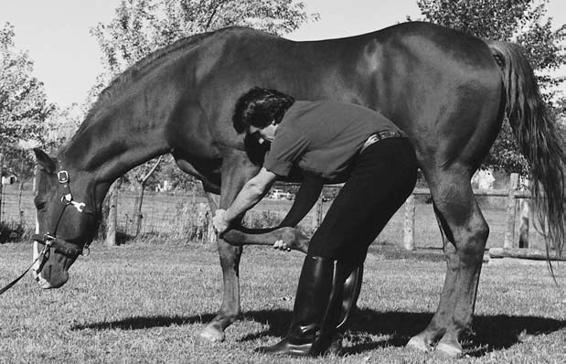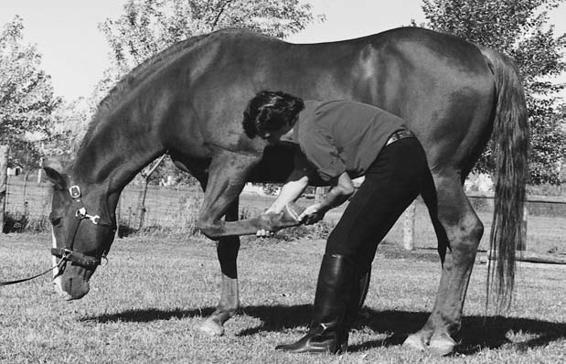Equine Massage: A Practical Guide (33 page)
Read Equine Massage: A Practical Guide Online
Authors: Jean-Pierre Hourdebaigt

The Development Stretch
Once the horse gets used to the easy stretch, you can work into the development stretch, holding the stretch for 30 seconds or more. Start with the easy stretch. Pass the initial 30 seconds; as the muscle tightness decreases, adjust your traction until you again feel a mild tension. Hold for another 10 to 15 seconds. Repeat 2 to 3
times until you feel you have reached the maximum stretching
Stretching
175
capacity of the muscle. Do not exceed a total of 2 or 3 minutes on any given stretch. Avoid triggering the stretch reflex caused by overstretching. Be in control.
Spontaneous Stretch
Often during the development stretch and sometimes during the easy stretch, the horse will spontaneously stretch himself fully for a few (5 to 10) seconds. This is a definite sign that the animal is enjoying the stretch and needs it very much.As you hold the limb during such spontaneous release, you can feel all the deep tension coming out as a strong vibration; it is quite an experience. After such a release, there is no need to hold the stretch further. Bring the limb back to its natural position.
Counting
The time-frame in which you stretch a muscle is very important.
At first, silently count the seconds for each stretch.This will ensure that you hold tension for the correct length of time.After a while, you will develop a feel for this practice and will subconsciously know without having to count when the animal has reached his full stretching capability.
This practice of mental counting will bring the best results from the stretching technique. If not, let go gently and allow the limb to return to its natural position and repeat this treatment several hours later or the next day. Be aware of the horse’s reaction to the stretch before you repeat the exercise.You should also inves-tigate if any undue stress points or trigger points are present; release them with massage.
In summary, first start with the easy stretch for 15 to 30 seconds.
Then work into the development stretch. This activity will finely tune the muscles and increase overall flexibility. Do not overstretch; do not make jerky or bouncy movements. Never stretch an acutely (recently) torn muscle. Never twist the joint or force it into an abnormal range of motion. Always stretch the
agonist muscle
(the one responsible for the action) and its
antagonist muscle
(the one that has to let go for the action to happen). In other words, stretch in both directions of a joint’s movement.A regular practice of stretching with comfortable and painless movements will help you extend your animal’s current limit of flexibility.
Warning:
During stretching exercises, your posture is most important. (Position yourself as shown in chapter 3.) Using your body weight properly will contribute greatly to the good development of this technique. As you start stretching the limbs, especially the hind legs, posture is very important to prevent injury to
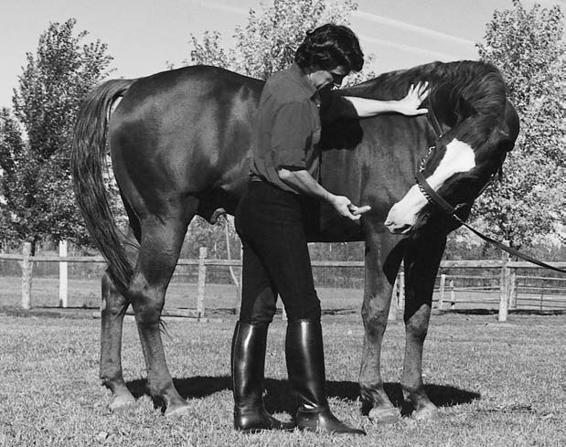
176
Equine Massage
your back. Flex your knees and use your leg muscles to absorb the tension. Keep your back straight and your shoulders relaxed. If the horse retracts a leg abruptly, your posture should allow you to absorb this unexpected jolt. If you are not properly positioned, your lower back will not survive very long! You will be the one who needs the massage and the stretching. Be relaxed as you work. Breathe deeply.
The Stretching Routine
Neck Stretches
Neck stretches will affect all aspects of neck muscle action. You can do all of them using a piece of carrot or other treat as incentive.This will make your work much, much easier.
Lateral Stretch:
Allow the horse to sniff the “incentive” and guide him toward the withers.As he follows your hand, the resulting movement will stretch both the extensor and flexor muscles of the neck. You can increase the lateral stretch by asking him to stretch further toward the point of the hip. Talk softly to your horse as you get him into the stretch. Do both the right and left sides.
8.1 Lateral Bending of the Neck:
Duplicate on other side; use a food
reward to make the work easier.
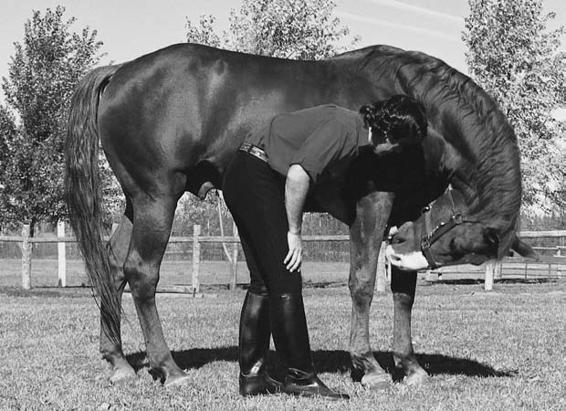
Stretching
177
8.2 Neck Flexion:
Again, use a food reward.
Neck Flexion Stretch:
As with the lateral stretch, use an “incentive” to guide your horse’s head downward, in between his legs, as close to the ground as possible. While performing this particular stretch, you can add a variation: as you bring the flexion down, move his head to the right or left.The extensor muscles will thus be thoroughly stretched.
Neck Extension Stretch:
As with the other neck stretches, use an “incentive” to guide the horse’s head upward and out as far as it can go. Do not force this movement.The horse will get into it freely once you show him how. This movement will stretch the neck’s flexor muscles.
Foreleg Stretches
The Shoulder Extension Stretch:
This protraction movement will stretch the muscle involved in the retraction of the foreleg.
With a little pinch, pick up the leg above the fetlock joint, take the hoof with one hand and place the other behind the knee.
Gently bring the leg forward and upward. This stretch will affect the muscles of the shoulder, the trapezius muscle, the latissimus dorsi muscle, the serratus thoracis muscle, the deltoid muscle, and the triceps muscles. Once the horse is well into the stretch, maintain the tension with one hand behind the knee and with the other hand extend the hoof.This action will deepen the
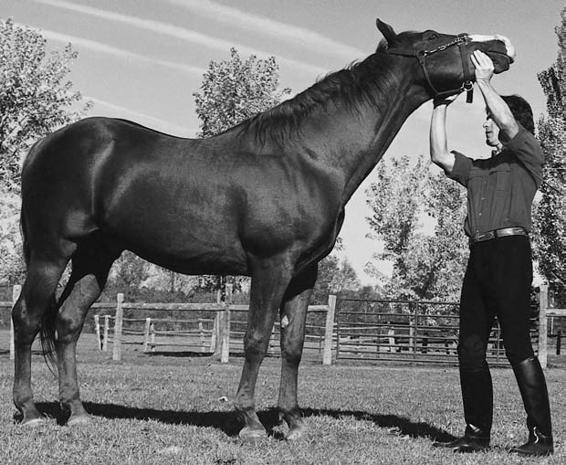
178
Equine Massage
8.3 Neck Extension:
Progressively bring the head into this position.
flexor tendon stretch as well as the suspensory ligament stretch. Be gentle and cautious.
The Shoulder Flexion Stretch:
This retraction movement will stretch the muscles involved in the protraction of the foreleg. Pick up the leg with a little pinch above the fetlock joint and with one hand take hold above the hoof. Place the other hand in front and above the knee joint. Gently bring the leg backward until the radius is at a 90-degree angle to the ground.This is a good stretch for the muscles of the chest and the upper leg: the pectoral muscle, the brachiocephalic muscle, the biceps muscle, and the extensor carpi radialis muscles.
The Fetlock Stretch:
To complete the stretching movement of the forelimb, bend the leg at the knee and alternately flex and extend the fetlock joint. Secure your grip with one hand, holding the cannon bone firmly, and with the other hand move the hoof.
This stretch is good for the structure of the lower leg and ankle, the common digital extensor tendon, the extensor carpi radialis tendon, the lateral digital extensor tendon, and the suspensory ligament.This action positively affects the strong ligament structures of the lower leg.
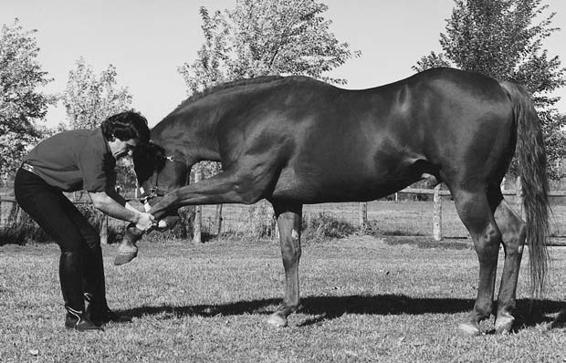
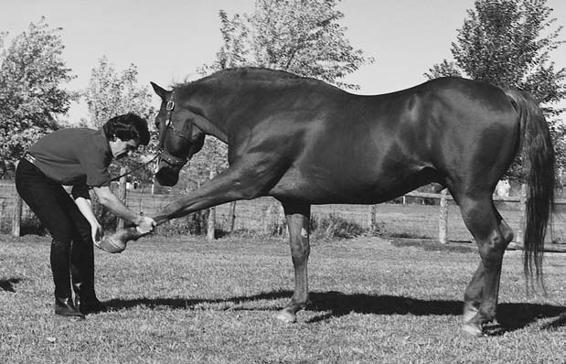
Stretching
179
8.4 Shoulder Extension Stretch:
This protraction stretching movement is
good for stretching the flexor muscles of the leg.
8.5 Shoulder Extension Deep Stretch:
This version is done after the initial
stretch and allows for extra stretching of the flexor tendon and the suspensory ligament.
